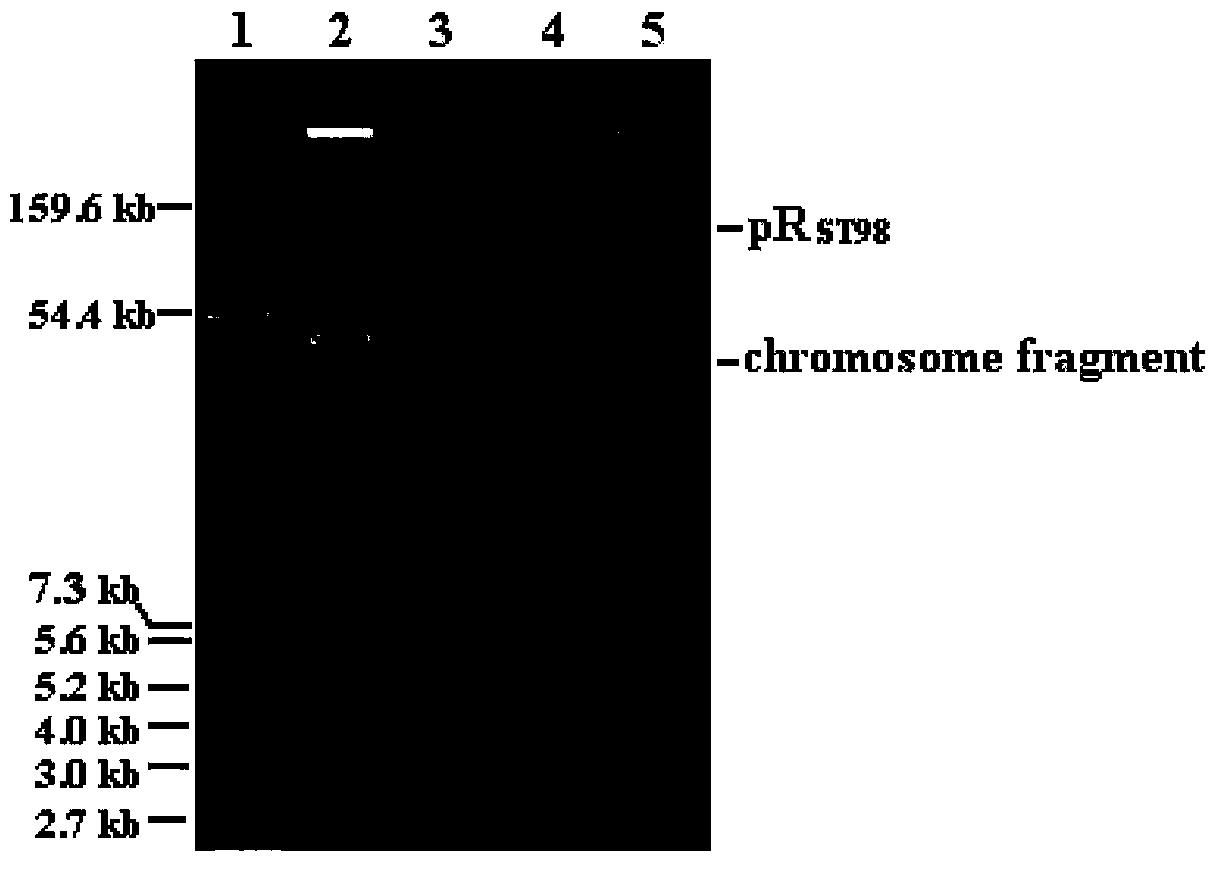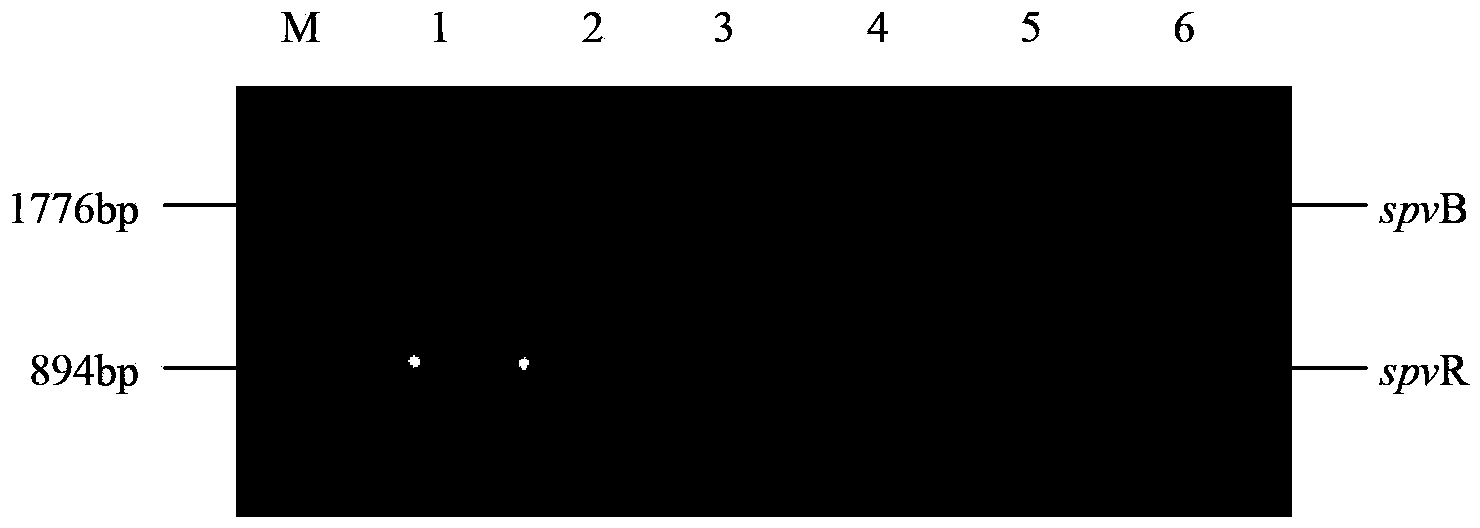Salmonella typhimurium X3337-pRST98lux and its application in living imaging
A technology of x3337-prst98lux and Salmonella, applied in the field of microorganisms, can solve the problems of inability to track bacterial invasion, proliferation and spread in real time, difficulty in quantification, low detection specificity, etc., and achieve the effect of stabilizing bioluminescent performance
- Summary
- Abstract
- Description
- Claims
- Application Information
AI Technical Summary
Problems solved by technology
Method used
Image
Examples
Embodiment 1
[0027] Specific construction and identification of strains:
[0028] 1. Material preparation
[0029] 1.1 Plasmids and strains
[0030] 1.1.1 Electroporation of plasmids and strains
[0031] Plasmid pBEN276 was kindly donated by Prof. Pierre Germon, Laboratory of Animal Infectious Diseases and Public Health Pathogen Research, French Institute of Natural Resources. 【Kevin Howe, Attila Karsi, Pierre Germon, et.al.Development of STable reporter sysTem cloning luxCDABE genes into chromosome of Salmonella enterica serotypes using Tn7transposon[J].BMC Microbiology2010,10:197】
[0032] Salmonella typhimurium (Salmonella typhimurium) X3337 was kindly provided by Professor ROY CURTISS III, School of Biological Sciences, Arizona State University, USA. [HIDENORI MATSUI, CHRI ST OPHER M. BACOT, WENDYA. Virulence Plasmid-Borne spvB and spvC Genes Can Replace the 90-Kilobase Plasmid in Conferring Virulence to Salmonella enterica Serovar Typhimurium in Subcutaneously Inoculated Mice [J...
Embodiment 2
[0081] Application of Salmonella typhimurium (Salmonella typhimurium) X3337-pRST98lux in vivo infection model
[0082] 1. Bacterial culture
[0083] Select a single clone from the solid LB agar plate and inoculate it into LB liquid medium, and culture at 37°C and 200rpm for 14-16h until the logarithmic growth phase. Collect bacteria by centrifugation at 4000rpm, 4°C, 10min, wash twice with normal saline (4000rpm, 4°C, 10min), resuspend with appropriate amount of normal saline, measure OD 600 Calculate the bacterial concentration. Gradiently diluted with normal saline for use.
[0084] 2. Mice Grouping and Infection
[0085] All mice were given standard feed and free drinking water, and kept at room temperature (22°C). 54 mice were randomly divided into 3 groups: X3337-pRST98lux infection group and X3337lux infection group, 24 each, and normal saline control group, 6 mice. Intraperitoneal (i.p.) injection of 0.1 mL, 10 5 CFU bacteria, the control group was injected with t...
Embodiment 3
[0089] Application of Salmonella typhimurium (Salmonella typhimurium) X3337-pRST98lux in cell infection model
[0090] 3.1 Preparation of cell infection model
[0091] HeLa cells in the logarithmic growth phase were digested with trypsin, and washed twice in 10% wt FBS antibiotic-free RPMI1640 culture medium (centrifuged at 1000r / min for 10min). Adjust the cell concentration to 3.5×10 with cell culture medium 5 cells / mL, add 2 mL / well into 6-well cell culture plate, 5% CO 2 , Cultivate overnight at 37°C.
[0092] Collect the test bacteria cultured to the logarithmic growth phase, centrifuge at 4500r / min, 4°C for 5min, remove the supernatant, wash the bacteria twice with sterilized normal saline, and use antibiotic-free RPMI1640 culture medium containing 10%wt FBS After dilution, the multiplicity of infection (MOI) ratio of bacteria to cells was 100:1, respectively added to cell culture plates, and a control group without adding bacteria was set up. Centrifuge at 1000r / min,...
PUM
 Login to View More
Login to View More Abstract
Description
Claims
Application Information
 Login to View More
Login to View More - R&D
- Intellectual Property
- Life Sciences
- Materials
- Tech Scout
- Unparalleled Data Quality
- Higher Quality Content
- 60% Fewer Hallucinations
Browse by: Latest US Patents, China's latest patents, Technical Efficacy Thesaurus, Application Domain, Technology Topic, Popular Technical Reports.
© 2025 PatSnap. All rights reserved.Legal|Privacy policy|Modern Slavery Act Transparency Statement|Sitemap|About US| Contact US: help@patsnap.com



